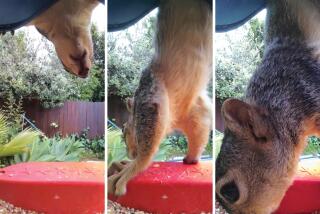Fall’s in the Air--and It Stinks : Wildlife: Autumn brings skunks to quiet Linda Way in Los Alamitos. Residents tell horror stories of dug-up lawns, injured pets and a nauseous odor that lingers for days.
- Share via
LOS ALAMITOS — Everyone agrees the problem stinks.
Each year, around September to early December, a sickening odor descends on Linda Way, a quiet neighborhood of single-family houses close to the Armed Forces Reserve Center and a county flood control channel.
It has been like the curse of autumn, residents say, as skunks visit the neighborhood almost nightly, leaving behind dug-up lawns, injured house pets and a nauseous odor that stays for days.
“It’s like I live with skunks. I smell it all the time,” said Linda Steiner, who has lived on Linda Way for the past 12 years.
On a Sunday night about two weeks ago, Steiner said she woke up about midnight with a splitting headache from the smell.
“I covered my nose with my pillow, but it didn’t help,” she said. “I doused my arm with perfume and stuck my nose to it. I didn’t sleep till morning.”
Steiner’s neighbor, Lucille Kuczwara, recently found diggings on her lawn. Across the street, Marvin Deman said that one morning he found his front and back yards dug up.
There are horror stories up and down the block. A year ago, Karen Haight said a skunk died under her house and it cost her more than $600 to eliminate the smell. That same day, she said, her daughter called from school crying because classmates were teasing her that she smelled like a skunk.
“That was the worst experience of my life,” Haight said. “I was on the phone all day , calling the city, the county, Animal Control. Everyone told me it was not their job to pick up the dead skunk.”
In other areas of the city, residents are complaining too. They have complained to the City Council, and frustrated city officials have asked County Animal Control for help.
“It’s a real tough one. I don’t know if anybody has the answer,” said Los Alamitos Public Services Director Jerry Andersen. “What we can do is learn to coexist” with the skunks.
Whether it’s coyotes or skunks, more and more wild animals are being forced out from their natural habitat and are causing problems in many neighborhoods, according to Animal Control officials.
It’s worse in cities on the edges of the county and those that still have large pockets of open space, like Los Alamitos, where the huge Army Reserve base, the race track and a golf course in Cypress next door provide havens for the animals, officials said.
“One way (to get rid of the skunks) would be to trap and kill them. But we’re not in the killing business,” County Animal Control Director Jack Edwards said at a recent Los Alamitos City Council meeting.
There are two kinds of skunks in California: the striped skunk, which is about the size of a house cat and has two broad white stripes running from the back of the head to the large, bushy tail; and the spotted skunk, smaller and with four irregular white stripes beginning behind the eyes and below the ears.
They are nocturnal animals that usually live in underground burrows, hollow logs, rock piles or under houses. They eat food of almost any variety, including insects and fruit, game birds, poultry and eggs. They often dig up lawns to look for insects.
When threatened, skunks eject a yellow substance containing oily compounds, which have a nauseating odor. A direct hit in the eye can produce temporary blindness. A skunk can hit its mark at a distance up to 12 feet.
Edwards said to avoid attracting skunks, pet food should not be left outside. Using pesticide can also deter them, he said.
Residents on Linda Way, however, said they are taking all the preventive measures, with little success. Steiner’s husband, Kevin, said he favors trapping the animals and taking them away.
“I don’t care where they put them. I just want them out of here. But don’t kill them,” Kevin Steiner said.
Dave Emerson, a realtor, said he is worried that property values on his block may go down because of the skunk problem. “Nobody wants to live in a skunk-infested block,” he said.
Emerson said some members of the City Council have been helpful, but some city employees have been sitting on the problem. He said it was wrong for Andersen, the city services director, to say that residents have to learn to coexist with the skunks.
“Let Mr. Andersen coexist with some skunks and let’s see how he feels,” Emerson said.
More to Read
Sign up for Essential California
The most important California stories and recommendations in your inbox every morning.
You may occasionally receive promotional content from the Los Angeles Times.










